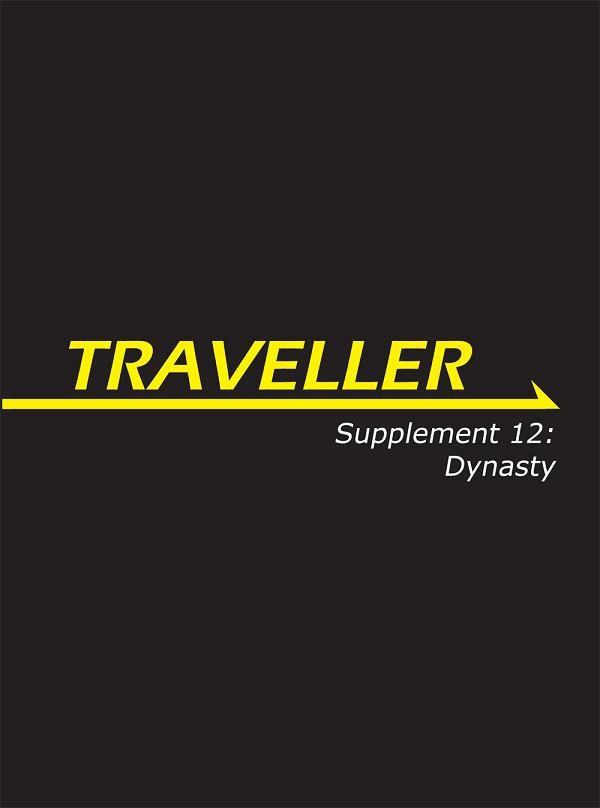Mongoose Traveller Supplement 12: Dynasty
This article appeared in the January 2012 issue of the magazine
 Mongoose
Traveller Supplement 12: Dynasty. Bryan Steele.
Mongoose
Traveller Supplement 12: Dynasty. Bryan Steele.
Mongoose Publishing http://www.mongoosepublishing.com
96pp, softcover
US$24.99/UKú16.99
On the Shelf
As with all of the non-setting-specific supplements, Dynasty sports the Mongoose Traveller solid black cover, with “TRAVELLER” and arrow in yellow. The tagline is “The Rise and Fall”.
Initial Impressions
The primary focus of this volume is not the normal player-character level; rather, it focuses on the generational-level machinations and conflicts between large organizations (dynasties). There are provisions for creating a dynasty based on player-characters, and for generating player-characters based on dynastic characteristics, but these are clearly secondary to the focus on the dynasty itself, and form only a weak bridge at best between the traditional player-character and dynastic levels of play.
On Closer Inspection
Although the typical definition of ‘dynasty’ implies continuity of bloodline, Mongoose extends that definition to include other ‘lines of continuity’ in the form of common values and goals within the organization, with an eye toward maintaining and/or increasing the power/influence of the organization over time. Thus, under this book’s definition, one could say that Rupert Murdoch’s News Corp. or Microsoft is as much a dynasty as the House of Windsor—or the federal government of the United States of America. In the final analysis, though, what a dynasty has, that makes it a dynasty, is influence over others. The various trapping of power—troops, money, whatever—are all simply tools for gaining that influence, or exercising it once you have it.
A dynasty is treated in some respects like a player-character—it has certain core characteristics, from which secondary traits, aptitudes (somewhat analogous to skills), and values are derived, and those characteristics, traits, aptitudes, and values influence the outcome of the various die rolls that represent the dynasty’s continuing history—which in turn reflect back on and modify the characteristics, traits, aptitudes, and values, creating various effects on the dynasty and its ability to survive over time.
The player’s direct influence over that continuing history is managed through the establishment of goals for each ‘turn’ (a decade). A given goal is broken down into a set of checks against characteristics, traits, aptitudes, and/or values; success sufficient to meet each of the indicated subgoals results in the overall goal being achieved; in the process, characteristics, traits, aptitudes, and values may be affected, producing additional influences on the dynasty’s ability to survive and/or meet future goals.
There is a section on conflict between dynasties; most of the material is written with the assumption that the player-character is the aggressor in an interdynastic conflict, and describes the strategies, benefits, and penalties from that point of view. Very little space is given over to actually defending against such attacks, however.
Play at this level is distinctly more complex than at the player-character level. Going over the various processes several times will be necessary to fully understand them and how they interact.
Overall, there is much emphasis on the idea that when playing at this level, nothing is absolutely out of the question. Most of the book is guidelines and ideas; the author repeatedly suggests that referees and players come up with their own similar ideas and discuss them, and not limit dynastic play strictly to the structures, ideas, and goals set forth in the book.
There are two sections on play at the player-character level “in” a Dynasty game; the first is about using the dynasty’s characteristics et cetera as influences on the player-character’s career, providing bonuses in particularly appropriate career choices. The character so generated is not necessarily ‘larger than life’ as compared to a normal Traveller character, but the final character will unquestionably have benefited from his/her connection to the dynasty. The second section is essentially about using dynastic history events as scenarios to “frame” player-character adventures—for example, a Conglomerate may generate the event “The power base suffers a major natural disaster, and the Conglomerate can lend charitable aid…”; this could frame a player-character-level scenario in which the player-characters are part of one of the teams that have been sent in by the conglomerate to render aid.
Conclusion
This supplement is definitely not for everyone. While it will appeal to a certain kind of player (and I admit to being such a player), it is less about actually playing a role-playing game than it is about writing the history of an organization that appears as a major player in the background to a setting for a role-playing game. That’s not to say that it’s a bad supplement, which shouldn’t have been written and released; it does have its place on the Traveller bookshelf, but more as a tool for a referee to use for background development than for influencing play. The typical player probably should give this volume a miss; the referee who likes to develop a rich background should probably grab it with both hands.
 Freelance
Traveller
Freelance
Traveller